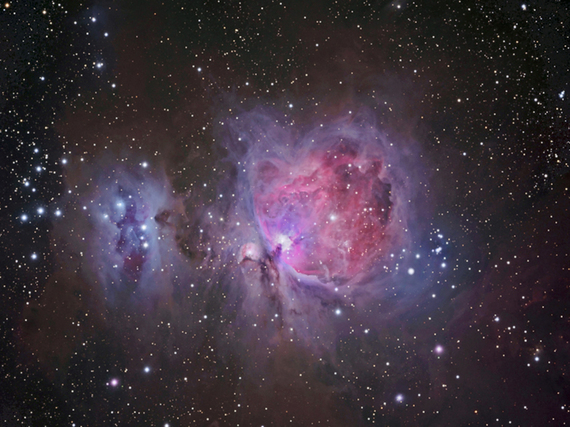The Orion Nebula
 Click Image for full size view Warning: Full size images can be very large |
By |
Catalog |
Obj Type |
Location |
Date Taken: |
SSRO Published |
Messier 42 |
Nebula |
Mayhill, NM |
12-13-2004 |
Description |
||||
M42 was discovered in 1610 by Nicholas-Claude Fabri de Peiresc. Located at a distance of about 1,600 light years from Earth, the Orion Nebula is the brightest diffuse nebula in the sky, visible to the naked eye and quite rewarding in telescopes of all sizes, from the smallest refractors to the Hubble Space Telescope. It is the main part of a much larger cloud of dust and gas which extends over 10 degrees covering well over half the constellation Orion. The linear extent of this giant cloud is over several hundred light years. It can be seen in long exposure images and contains, besides the Orion Nebula near its center, the following objects: Barnard's Loop, the Horsehead Nebula region, and the reflection nebula M78. Already impressive in deep visible light images, the Orion Cloud is especially gorgeous in infrared light images. Processing Notes: This was our first attempt at using unbinned color and the result clearly shows that it works well for the FSQ / STL-11000M combination - yielding both good detail and vibrant color. This image was vastly improved by some short exposure data added by our good friend Don Goldman. The composite of the longer (10 minute) subexposures and Don's short subexposures yield good detail throughout the object. New for 2006! To see a wide-field version of M42 created by Jimmy from the original 2004 data, click here. |
||||
Technical Details |
||||
Exposure Time: |
RGB (100, 100, 100 minutes) all binned 1x1 plus short exposures | |||
Camera: |
SBIG STL-11000M | |||
Telescope: |
Takahashi FSQ106N | |||
Mount: |
Software Bisque Paramount ME | |||
© 2025 SSRO Published Used with permission, No reproduction of these images are permitted without written approval from SSRO Published. |
||||
